英汉翻译第四章教案
- 格式:doc
- 大小:91.00 KB
- 文档页数:13
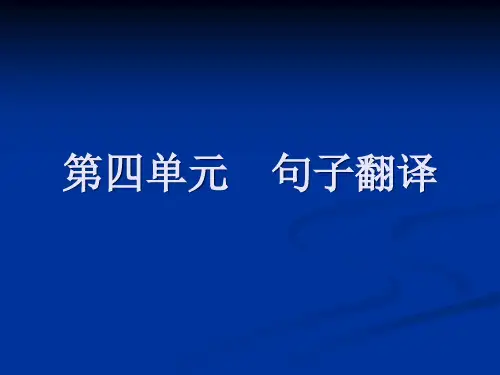

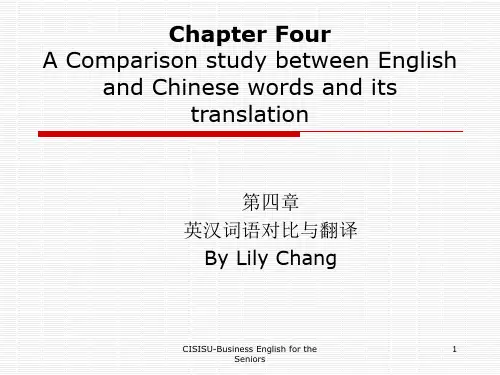
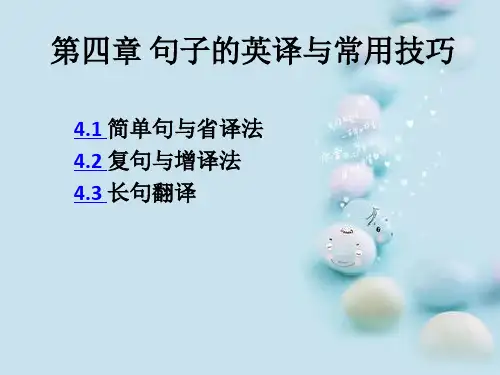

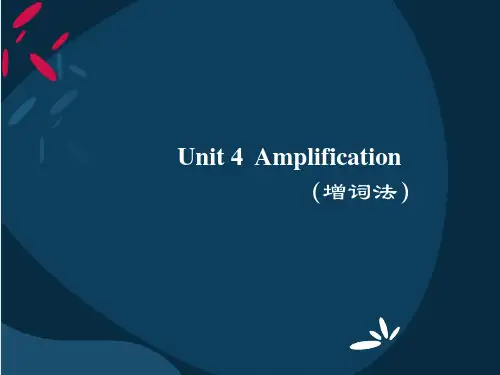

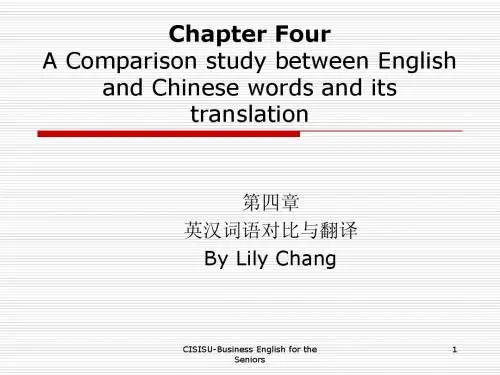


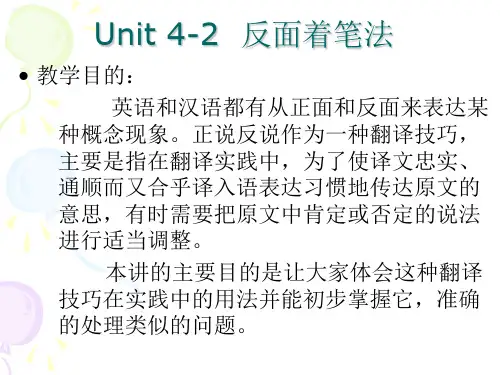
英汉翻译实用教程教案第一章:翻译概念与原则1.1 翻译的定义解释翻译的概念和本质强调翻译的目标:传递信息、保持原文意义和风格1.2 翻译原则准确原则:确保翻译内容的准确性忠实原则:保持原文的精神和风格通俗易懂原则:确保译文适合目标读者对等原则:尽量找到等效的表达方式1.3 翻译标准解释中国的翻译标准:信、达、雅探讨翻译标准的实际应用和灵活性第二章:翻译技巧与策略2.1 直译与意译解释直译和意译的概念及适用场合强调直译和意译的平衡使用2.2 词义转换与词性变化介绍词义转换的技巧:根据上下文确定词义讲解词性变化的方法:名词转译为动词、形容词转译为副词等2.3 长句翻译分析长句的结构和特点讲解长句翻译的策略:断句、合句、调整语序等第三章:英汉语言对比与翻译3.1 英汉语言特点对比分析英语和汉语的语音、语法、词汇等方面的差异强调了解和掌握这些差异对翻译的重要性3.2 文化差异与翻译介绍英汉文化差异对翻译的影响讲解翻译中文化适应和文化保留的方法3.3 翻译中的常见问题和解决方法分析英汉翻译中常见的困难和问题提供解决这些问题的方法和技巧第四章:不同文体翻译技巧4.1 文学翻译技巧讲解诗歌、小说、戏剧等文学作品的翻译方法强调文学翻译中的艺术性和创造性4.2 商务翻译技巧介绍商务合同、广告、报告等文体的翻译要点强调商务翻译的准确性和专业性4.3 科技翻译技巧讲解科技文章、专利文件等文体的翻译方法强调科技翻译的准确性和专业性第五章:翻译工具与资源5.1 翻译软件与工具介绍常用的翻译软件和在线翻译工具强调翻译软件的辅助作用,不能完全依赖5.2 参考资料与资源介绍翻译中常用的参考资料:词典、手册、专业书籍等强调广泛阅读和积累知识的重要性5.3 翻译团队与协作强调团队合作在翻译项目中的重要性介绍有效的翻译协作方法和工具第六章:口译技巧与实践6.1 口译类型与特点解释同声传译、交替传译等口译类型的区别强调口译中的即时性和准确性6.2 口译技巧讲解听力理解、短期记忆、语言表达等口译技巧强调练习和提高口译能力的重要性6.3 口译实践提供口译练习场景和实例鼓励学生进行模拟练习,提高口译实战能力第七章:本地化与国际化翻译7.1 本地化概念与流程解释本地化的概念和目的讲解本地化的流程:市场调研、翻译、适应性修改等7.2 国际化翻译介绍国际化翻译的原则和方法强调在翻译中考虑不同文化和市场的适应性7.3 翻译案例分析提供实际的翻译案例分析案例中的本地化和国际化翻译策略第八章:翻译评估与反馈8.1 翻译质量评估标准介绍翻译质量评估的主要标准:准确性、流畅性、忠实度等强调评估过程中的客观性和公正性8.2 翻译错误分析分析常见的翻译错误类型:语义错误、语法错误、文化错误等提供避免和纠正这些错误的方法8.3 翻译反馈与改进强调反馈在翻译过程中的重要性讲解如何有效地接收和利用反馈,提高翻译水平第九章:翻译职业规划与发展9.1 翻译职业概述介绍翻译行业的现状和发展趋势强调翻译职业的挑战和机遇9.2 翻译职业规划指导学生进行翻译职业规划提供提升翻译能力和职业发展的建议9.3 翻译伦理与职业素养介绍翻译职业的伦理规范和职业素养强调翻译工作中的责任感和专业精神第十章:翻译案例研究与分析10.1 经典翻译案例研究分析经典的翻译案例:文学作品、历史文献、名人演讲等讲解案例中的翻译策略和技巧10.2 现代翻译案例分析分析现代社会中的翻译案例:广告、电影、网络内容等强调翻译在现代社会中的重要作用和影响力10.3 学生翻译作品点评提供学生的翻译作品点评作品中的优点和不足,提出改进建议重点解析本文教案主要围绕英汉翻译实用教程展开,涵盖了翻译概念、原则、技巧、策略、英汉语言对比、翻译工具与资源、口译技巧与实践、本地化与国际化翻译、翻译评估与反馈、翻译职业规划与发展以及翻译案例研究与分析等十个章节。
Lesson 4Activity 1 RevisionTranslation of the words, phrases and sentences what we learned last time Activity 2 Nida’s theory of translation--New Attitudes withRespect to the Receptor LanguageSome of the basic difficulties in translating are caused by the wrong views people often have of the receptor and the source languages. Because of this, in order to do well in translating, translators often need to change their view of the languages in which they are working. This task aims at helping you rethink of your attitude toward your receptor language. In our case, this is of course Chinese or English.Now go through the following four passages adapted from Nida and Taber (1969) and try to summarize each one in one sentence in the space provided. Passage 1First of all, it is essential to recognize that each language has its own genius. That is to say, each language has certain distinctive characteristics, e.g., word-building capacities, unique patterns of phrase order, techniques for linking clauses into sentences, markers of discourse, and special discourse types of poetry, proverbs, and songs. Each language is also rich in vocabulary for the areas of cultural focus, e.g. cattle in Sudan, hunting and fishing in Peru, or technology in the western world.Each language has its own geniusPassage 2When translating, one must respect the features of the receptor language and exploit its potentialities to the greatest possible extent. There are some unfortunate cases where translators have actually tried to “remake” a language. For example, one missionary in Latin America insisted on introducing the passive voice of the verb into a language which had no such form. Not surprisingly, his efforts turned out to be futile. One must simply accept the fact that there are many languages which do not have a passive voice. They merely choose to report actions only as active.To communicate effectively one must respect the genius of each language. Passage 3Some translators do not see how people who have no snow can understand a passage that speaks about “white as snow”. The answer to this question is varied. Firstly, many people have a word for snow even if they have not themselves experienced it. Secondly, in other instances, people do not know snow, but they do have “frost” and they speak about the twowith the same term. Thirdly, many languages have other equivalent idioms, e.g., “white as egret(白鹭) feathers”, or “white as fungus (菌类, 蘑菇)” (if there is an especially white form of fungus). The point is that snow as an object is not crucial to the original message. Of course if the form in which a message is expressed is an essential element of the message itself, then there is a limitation in communicating the message from one language to another.Anything that can be said in one language can be said in another, unless the form is an essential element of the message.Passage 4Since all languages differ in form, quite naturally the forms must be changed if one is to preserve the content. The extent to which the forms must be changed in order to preserve the meaning depends on the linguistic and cultural distance between the source and receptor languages. The easiest transitions occur when one translates from a language such as English into German for the two are quite similar to each other both linguistically and culturally. On the other hand, if one is translating from English into Hungarian, the formal shifts will be greater, for Hungarian belongs to a different language family than English. However, Hungarian is still part of the same cultural setting as English. Hence, the shifts are not so extreme. If however, one has to translate from English into Zulu, which belongs t the so-called Bantu family of languages and represents quite a different culture, the formal modifications must be more extreme.To preserve the content of the message the form must be changed. Naturally, a new attitude towards the receptor language implies a new view of the source language as well. We don’t have to go into the great details in this respect, for there are a lot of similarities between the attitude concerning the receptor language and that concerning the source language. It suffices (vi.足够, 有能力vt.使满足) our purpose to bear in mind the following three implications with respect to the source language. (1) The source language is subject to the same limitations as any other natural language; (2) the writers of the source language expect to be understood; and (3) the translator must attempt to reproduce the meaning of a passage as understood by the writer.Activity 3 Languages Differ: Differences in Clause OrderWe have done some serious thinking about the nature of translating. Well, to be a good translator, only serious thinking is not enough. We should also practice as hard as we can and as much as we can. In this activity, we shift our attention to examining the differences in clause order between English and Chinese and the impact this has on our translating. In Chinese, we say就要毕业的学生们仍在教室里学习 while in English the same meaning is presented as Those students who were to graduate very soonwere still studying in the classroom. In the Chinese sentence, the attributive就要毕业的 is placed before 学生们 and the adverbial 在教室里 is placed before 学习, while in the English sentence, the attributive who were to graduate very soon is put after those students and the adverbial in the classroom is put after studying.Task 1 Where to Put the AttributiveQuestions:1.In Chinese, where is an attributive put?2.In English, where is an attributive put?3.Is there a difference between the word attributive and phraseattributive concerning their positions in a sentence?(Both in English and Chinese)In English, when a word is used as an attributive to modify a noun, it is usually placed before the noun, though on some rare occasions it can also be placed after noun. In Chinese an attributive is almost always put before the noun it modifies.Now translate the following phrases into Chinese, paying special attention to the positions of the attributives.1.a well-managed company 一家管理完善的公司2.the architect’s luxurious house 建筑师的豪华住宅3.the ancient Chinese philosophers 中国古代的哲学家们4.something urgent 紧急的事情5.somewhere unknown 不为人所知的某个地方Of course, not only can single words serve as attributives, but short phrases as well. In English, when a short phrase is used as an attributive to modify a noun, it is usually placed after the noun, while in Chinese it is usually put before the noun.Now translate the following items into Chinese, again paying special attention to the positions of the attributives.1.a project of building up the first corpus of spoken Chinese in China (创立中国第一个汉语口语语料库的项目)2.a student with a lot of complaints for the university(一个对学校颇多抱怨的学生)3.particles moving round their atomic nucleus(环绕原子核运动的粒子)4.a machine able to recognize human voice(能识别人的声音的机器)5.a girl wearing a long white dress(穿着白色长裙的姑娘)6.a book easy to read(一本容易读的书)Read the textbook P23-24Conclusion: Usually in English, the word attributive is put before the noun, and the phrase attributive is put after the noun, but in Chinese, it is almost always for attributives to be put before the noun.Task 2 Where to Put the Adverbial1.In Chinese, where is an adverbial put?2.In English, where is an adverbial put?3.Is there a difference between the word adverbial which modifies an adjective and the word adverbial which modifies a verb concerning their positions in a sentence?(Both in English and Chinese)Now translate the following sentences into Chinese or English, paying special attention to the positions of the adverbials.1.She was not particularly beautiful, but she certainly left a deepimpression on everybody.(她并不是特别地美丽,但她显然给每个人都留下了深刻的印象。
第4章Unit 4 Economy1. 经济文章选篇。
其特点是:着重说明经济形势,提出主张和建议,以大量数据说明问题。
所用语言视场合而定,文件的语言正式而精练,演讲的语言则要比较易于上口。
2. 语言对比:(1)经济术语。
经济领域有大量的专门术语。
如:two way trade双向贸易l ucrative export markets 获利的出口市场foreign exchange 外汇commercial opportunities商业机会export opportunities 出口机会potential exports潜在市场(2)有些普通词语在经济文章中有特殊含义。
经济术语有特殊的用法和搭配。
例1)The result, I believe, is that we have built the beginnings of a sound foundation for future commercial and financial ties.我相信我们已经为今后贸易与金融关系初步打下了坚实的基础。
例2)There are more than 20 joint ventures between the US and Chinese investors.现在有20多家中美合资企业。
(3)数字及有关的术语和量词。
数字很容易出错,因此要特别仔细核对。
和数字有关的动词、介词、形容词、副词也很重要。
如“增加了”和“增加”表示的意思是不一样的。
by用来表示增加或减少的幅度。
表示倍数时汉语与英语不一样。
汉语:1)甲比乙...(形容词或副词)n倍:不包括基数。
2)甲是乙n倍:包括基数。
英语:1) "n+ times + adj.比较级+than"式:包括基数;2) "n+ times + as + adj. + as"式:包括基数;3) "verb (e.g. increase, grow, rise, be raised, etc.) + n + times"式:包括基数。
《英汉互译》教案与讲义教案章节一:英汉互译概述教学目标:1. 了解英汉互译的基本概念和原则。
2. 掌握英汉互译的基本技巧和方法。
3. 能够进行简单的英汉互译实践。
教学内容:1. 英汉互译的概念和定义。
2. 英汉互译的原则和标准。
3. 英汉互译的基本技巧和方法。
4. 英汉互译的实践案例分析。
教学活动:1. 引入英汉互译的概念和定义。
2. 讲解英汉互译的原则和标准。
3. 介绍英汉互译的基本技巧和方法。
4. 提供实践案例,让学生进行翻译练习。
教学评价:1. 学生能够回答英汉互译的概念和定义。
2. 学生能够理解英汉互译的原则和标准。
3. 学生能够掌握英汉互译的基本技巧和方法。
4. 学生能够进行简单的英汉互译实践。
教案章节二:词汇与翻译1. 了解词汇在英汉互译中的重要性。
2. 掌握英汉词汇的差异和转换方法。
3. 能够准确翻译词汇和短语。
教学内容:1. 词汇在英汉互译中的作用和重要性。
2. 英汉词汇的差异和转换方法。
3. 常见词汇和短语的翻译实例。
教学活动:1. 引入词汇在英汉互译中的作用和重要性。
2. 讲解英汉词汇的差异和转换方法。
3. 提供常见词汇和短语的翻译实例。
4. 让学生进行词汇翻译练习。
教学评价:1. 学生能够理解词汇在英汉互译中的重要性。
2. 学生能够掌握英汉词汇的差异和转换方法。
3. 学生能够准确翻译常见词汇和短语。
教案章节三:语法与翻译教学目标:1. 了解语法在英汉互译中的重要性。
2. 掌握英汉语法的差异和转换方法。
3. 能够正确翻译句子和段落。
1. 语法在英汉互译中的作用和重要性。
2. 英汉语法的差异和转换方法。
3. 常见语法错误的分析和纠正。
教学活动:1. 引入语法在英汉互译中的作用和重要性。
2. 讲解英汉语法的差异和转换方法。
3. 提供常见语法错误的分析和纠正。
4. 让学生进行句子和段落的翻译练习。
教学评价:1. 学生能够理解语法在英汉互译中的重要性。
2. 学生能够掌握英汉语法的差异和转换方法。
英汉翻译实用教程教案第一章:翻译的基本概念与原则1.1 翻译的定义1.2 翻译的类型与分类1.3 翻译的基本原则1.4 翻译的标准与评价第二章:英汉语言对比与翻译2.1 英汉语言特点对比2.2 英汉思维方式与文化差异2.3 词义、句法与语篇的转换2.4 翻译中的语言调整与适应第三章:直译与意译3.1 直译的概念与原则3.2 直译的适用场合与应用实例3.3 意译的概念与原则3.4 意译的适用场合与应用实例第四章:翻译技巧与策略4.1 词汇翻译技巧4.2 句子翻译技巧4.3 语篇翻译技巧4.4 翻译策略与应用实例第五章:计算机辅助翻译工具与技巧5.1 计算机辅助翻译软件介绍5.2 翻译记忆库的使用与维护5.3 网络资源在翻译中的应用5.4 机器翻译与人工翻译的结合策略第六章:翻译中的文化因素处理6.1 文化差异对翻译的影响6.2 翻译中的文化适应与调整6.3 文化负载词汇的翻译策略6.4 翻译中的文化冲突与解决方法第七章:翻译实践与案例分析7.1 文学作品的翻译实践7.2 实用文本的翻译实践7.3 本地化翻译实践7.4 翻译案例分析与评价第八章:专业领域翻译专题8.1 法律翻译专题8.2 医学翻译专题8.3 技术翻译专题8.4 其他专业领域翻译实例与分析第九章:翻译批评与翻译研究9.1 翻译批评的定义与作用9.2 翻译批评的标准与方法9.3 翻译研究的现状与趋势9.4 翻译学者与翻译作品评价第十章:翻译职业素养与伦理10.1 翻译职业素养要求10.2 翻译工作中的伦理问题10.3 翻译职业道德与职业行为规范10.4 翻译职业发展前景与建议重点和难点解析重点环节一:翻译的基本概念与原则补充和说明:翻译的定义需要强调跨文化交际的桥梁作用,类型与分类要详细解释文学翻译、实用翻译、本地化翻译等,基本原则要涵盖忠实、准确、流畅等方面,翻译的标准与评价则要提及语言、文化、交际等多维度的评价方法。
重点环节二:英汉语言对比与翻译补充和说明:英汉语言特点对比要分析语音、语法、词汇等方面的差异,英汉思维方式与文化差异要深入讨论东方与西方的思维模式及文化背景,词义、句法与语篇的转换要举例说明具体的翻译策略,翻译中的语言调整与适应要强调根据目标语的特点进行适当调整。